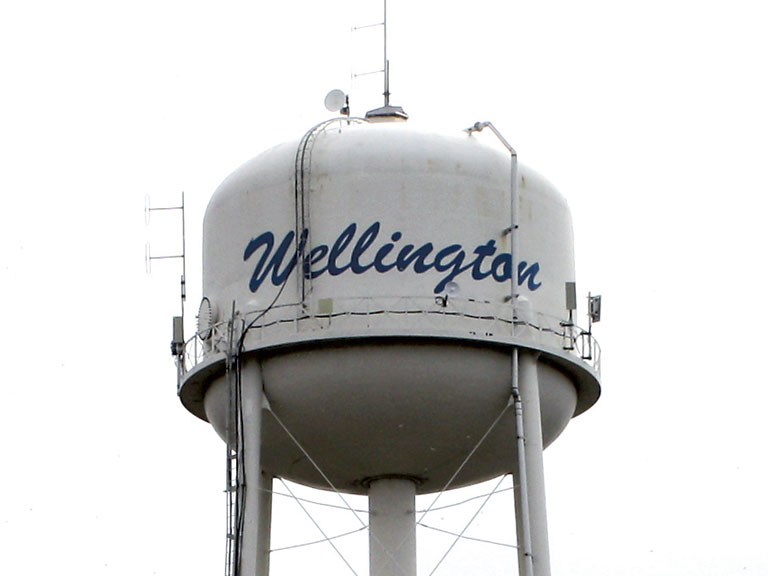County News
Master plan

Wellington’s growth potential stymied by infrastructure issues
Story: Corey Engelsdorfer
At Thursday’s Committee of the Whole, council was presented with a comprehensive staff report surrounding current water and wastewater challenges that are halting potential growth in Wellington. The challenge in Wellington is that the sheer magnitude of infrastructure investment required exceeds the County’s ability to pay and, without unique solutions, there will be considerable delay in bringing in much needed growth.
RVA, an engineering consultancy, unveiled its recommendations for Wellington’s waterworks, imagining a build-out to this future population. The costs of servicing Wellington’s water and wastewater needs rang in at $100 million for both expanded capital costs as well as maintenance and replacement of infrastructure, to be shared between the developers and ratepayers. While the full build-out cost is substantial, staff is suggesting a phased process to help alleviate the burden.
Through the Environmental Assessment process, it was found that Wellington is currently not satisfying acceptable fire flow capabilities. It was determined that a new water tower, as well as a new watermain trunk within the Millennium Trail, at a cost of $14.3 million, are both urgently needed to support the current population of 2,189 residents. County staff have put together a four-phase plan, which would see full build-out of Wellington take place in or around the year 2050. The expected number of residents at the time would be 8,600.
Over the next 10 years, staff estimates an increase in population of 1,655 residents, or 69 new units per year in the village. In recent years, development in Wellington has garnered roughly 30 permits per year, due strictly to the limited infrastructure capacity. With the upgrades, staff are anticipating growth to match, or even exceed Picton, which had 61 new water and wastewater connections in 2019.The 10-year immediate growth scenario will not only satisfy existing servicing deficiencies, but allow costs for this scenario, roughly $72.2 million, to be shared between new development and existing ratepayers, with the majority of the costs being absorbed by the growth sector. After this development has been completed, the project would move forward into the 20-year growth scenario, making way for another 1,800 residents.
To be clear, staff is suggesting that the County reach out to current developers to engage in negotiations for the potential of contribution agreements between the developers and the municipality. CAO Marcia Wallace noted that the hot market in Wellington, together with having developers already lined up at the door equates to “the perfect storm”. “This is by no means a done deal. The Wellington market is hot and there is a lot of interest to build now and quickly. We have a lot of negotiating to make sure the developers of major projects agree with the costing that has been outlined and what that means from an infrastructure build perspective and that they would agree to some kind of contribution agreement in exchange for a clear allocation in a phased way.” Wallace went on to explain that this type of plan has been applied in many suburban Toronto municipalities.
Councillor Jamie Forrester was nervous about dumping such a large amount of money into new waterworks based on projected growth. “I don’t want to see us get into another Picton water wastewater situation where we build a $30 million facility based on projected growth, which I don’t think has been very accurate over the years,” said Forrester. Planning Coordinator Cristal Laanstra noted that collecting money up-front would alleviate the risk. “By having the opportunity to look at contribution agreements up-front. If people are on the hook for potentially putting money in at the onset to develop, it’s more likely that money will come in and be built out as opposed to just municipal funds,” said Laanstra. Councillor Phil St. Jean believed this plan had been a long time coming. “The most important thing to me is that development pays for development. Growth pays for growth,” said St. Jean.
There are two main alternative options. Council could choose to debt finance the infrastructure investment. Costs would then be recouped through development charges over time, as development is built in phases. The main issue with this scenario is the restriction of the County’s ability to finance other infrastructure such as long-term care facilities or road construction. The other option is to only move forward with the required water upgrades for the existing community, and staff could rely on the planning policy from the secondary plan that restricts development that is premature. All proposals for development could be reviewed concurrently. This would allow council to make an informed choice about which development will take the remaining allocation in the system.
The motion to direct staff to engage with developers regarding contribution agreements passed, and will be ratified by council at a future meeting.

Comments (0)